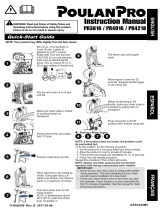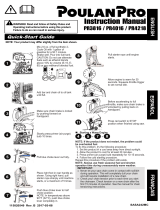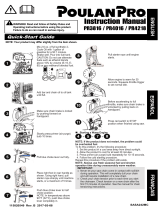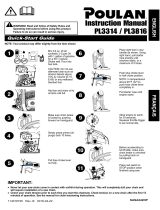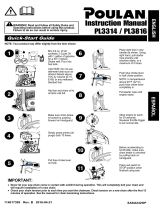
CLEAN FUEL FILTER
To clean fuel filter,drain your unit by
running dry of fuel, remove fuel cap/re-
tainer assembly from tank. Pull filter
from tank and remove from llne. Clean
with mild detergent and rinse. Dry thor-
oughly,reassemble.
CARBURETOR ADJUSTMENT
WARNING: The chain will be moving
during most of this procedure. Wear
your protective equipment and observe
all safety precautions. During the low
speed mixture adjustment recheck idle
speed after each turn of the screw. The
chain must not move at idle speed.
Carburetor adjustment is critical and if
done improperly can permanently dam-
age the engine as well as the carbure-
tor. if you require further assistance or
are unsure about performing this proce-
dure, calt our customer assistance help
line at 1-800-235-5878.
Old fuel, a dirty air filter, dirty fuel filter,
or flooding may give the impression of
an improperly adjusted carburetor.
Check these conditions before adjust-
ing the carburetor.
The carburetor has been carefully set at
the factory. Adjustments may be neces-
san/if you notice any of the following
conditions:
• Chain moves at idle. See "Idle Speed"
under adjusting procedure.
• Saw will not idle. See "Idle Speed"
and "Low Speed Mixture"under ad-
justing procedure.
• Engine dies or hesitates when it
should accelerate. See =Acceleration
Check" under adjusting procedure.
• Loss of cutting power. See "High
Speed Mixture H"under adjusting
procedure.
There are three adjustment screws on
the carburetor. They are labeled H, L,
and T. They are located in the area just
above the primer bulb.
CARBURETOR PRESETS
When making adjustments, do not force
the plastic timiter caps beyond the
stops or damage wifl occur.
If carburetor presets are not needed,
proceed to "Idle Speed-T."
• Turn both mixture screws counter-
clockwise until they stop.
• Turn the idle speed screw clockwise
until it stops. Now turn counterclock-
wise 4-1/2 full turns.
Start motor, let it run for 3 minutes, and
proceed to the adjustment section. If
engine does not start, refer totrouble-
shooting chart or call 1-800-235-5878.
if engine performance is acceptable at
the preset positions and there is no
chain movement at idle, no further ad-
justment is necessary.
ADJUSTING PROCEDURE
idle Speed-T
Allow engine to idle. Adjust speed until
engine runs without chain movement or
stalling.
• Turn clockwise to increase engine
speed ifengine stalls or dies.
• Turn counterclockwise to decrease
speed.
No further adjustments are necessary if
chain does net move at idle speed and
if performance is satisfactory.
Low Speed Mixture-L
Allow engine to idle. Then accelerate
the engine and note performance. If en-
gine hesitates, bogs down, or smokes
during acceleration, turn mixture screw
clockwise in 1/16-turn increments until
performance is satisfactory. Repeat this
procedure as necessary for proper ad-
justment. After completing adjustments,
check for acceleration and chain move-
ment at idle. Reset if necessary.
High Speed Mixture-H
DO NOT operate engine at full throttle
for prolonged periods while making ad-
justments. Damage tothe engine can
occur. Make a test cut. Based on per-
formance of the saw while cutting, ad-
just the high speed mixture setting in
1/16-turn increments as follows:
• Clockwiseuntilsaw has goodpower in
the cut withno hesitation.Do not adjust
by sound or speed, butjudge by how
well the saw perfoilT_ in the cut.
• Counterclockwise if the saw has
speed, but dies in the cut or lacks
power in the cut.
After completing adjustments, check for
acceleration and chain movement at
idle. Reset ifnecessary.
Acceleration Check
if the engine dies or hes_tes instead of
accelerating,turnthe low speed m_ure
adjustment counterclockwiseuntil you
have smooth acceleration with no chain
movement at idle, Recheck and adjust as
necessary for acceptable performance.
15




















